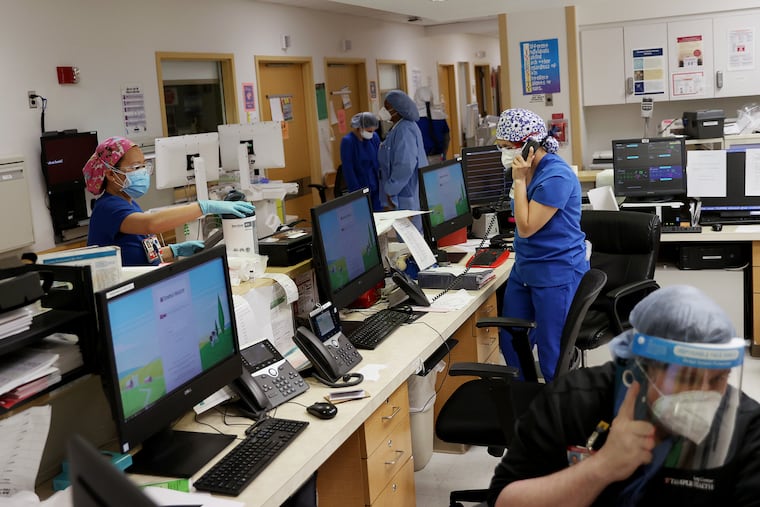Health-care business is down. Insurance premiums are another story, experts say
The billions of dollars lost by hospitals and physicians constituted huge savings for health plans, fattening their bottom lines. But that doesn’t mean consumers will see lower premiums next year.

When COVID-19 smacked the United States in March and April, health plans feared medical costs could skyrocket, jacking up premiums drastically in 2021, when millions of the newly unemployed might still be out of work.
But something else happened: Non-COVID care collapsed as hospitals emptied beds and shut down operating rooms to prepare for an expected onslaught of patients sickened by the coronavirus, while fear of contracting it kept people away from ERs, doctors’ offices, and outpatient clinics. In many regions of the country, the onslaught did not come, and the billions of dollars lost by hospitals and physicians constituted huge savings for health plans, fattening their bottom lines.
But that doesn’t mean consumers will see lower premiums next year.
Numerous insurers across the country have announced plans to hike rates next year, though some have proposed cuts.
A Kaiser Family Foundation analysis last week of proposed 2021 rates in the exchanges of 10 states and the District of Columbia showed a median increase of 2.4%, with changes ranging from a hike of 31.8% by a health plan in New Mexico to a cut of 12% in Maryland. Pennsylvania and New Jersey were not in the analysis because their data was not made publicly available in a way that allowed analysts to see how premiums are calculated.
Among the roughly one-third of filings that stated how much COVID-19 added to premiums, the median was 2%, with estimates ranging from minus 1.2% at a plan in Maine to 8.6% at one in Michigan.
The proposed premiums for ACA marketplace plans do not affect job-based coverage, but they may indicate how the pandemic is affecting premiums generally.
The consensus among industry experts is that COVID-19 has generated little pressure for rate rises, and health plans should err on the side of moderation. But some fear that many insurers will hold onto the reserves they’ve built up, citing the possibility of widespread vaccinations and concerns that the care forgone in 2020 could rebound with a vengeance next year.
“The tendency of health plans, when they are faced with any degree of uncertainty, is to be very conservative and price for the worst-case scenario,” said Michael Johnson, an industry observer and critic who worked as an executive at Blue Shield of California from 2003 to 2015. “Actuaries are less likely to get fired if the plan prices too high than if the plan prices too low. But I think regulators really need to push back hard on that.”
» FAQ: Your coronavirus questions, answered.
The benefits reaped by health plans so far in the pandemic can be seen in strong second-quarter earnings and reduced spending on care. UnitedHealth Group, the nation’s largest health insurer, announced earlier this month that its net profit in the April-June quarter nearly doubled from the same period a year earlier. Its medical spending plummeted from 83.1% of premium revenue to 70.2% over that period.
UnitedHealth said it has provided $1.5 billion worth of financial support to consumers so far, including premium credits and cost-sharing waivers, and expects to pay out $1 billion in rebates.
But UnitedHealth is seeking a rate increase of 13.8% in the New York exchange. Anthem is planning rate hikes of 16.6% in Kentucky and 9.9% in Connecticut.
On the other hand, Kaiser Permanente, which covers more than one-third of Covered California enrollees, plans rate cuts in other states, ranging from 1% in Hawaii to 11% in Maryland.
Peter Lee, executive director of Covered California, downplayed the notion of a financial boon for California health plans, saying that, partly because of the use of telehealth, primary care has rebounded and the plans are paying for it. “So we don’t see this as being at this point a bonanza year for health plans,” he said. “Rather, it’s a year in which there are lessons learned for how we can deliver care in a pandemic.”
Still, the health plans are in a far stronger position than they had feared earlier this year.
In June, projections commissioned by the industry’s national advocacy group, America’s Health Insurance Plans, showed that even in the worst-case scenario of a 60% COVID infection rate — far above where it stands now — the pandemic would increase medical costs in 2020 and 2021 by 6% at most, and could even decrease them.
That moderate effect is largely attributable to what Katherine Hempstead, a senior policy adviser at the Robert Wood Johnson Foundation, called “a kind of yin and yang: If you have a lot of COVID, you don’t have a lot of other health-care spending.”
Independent of the course the pandemic takes, emergency room and outpatient visits still lag behind pre-COVID levels and will probably continue to do so next year, to the continued benefit of insurers, predicted Glenn Melnick, a professor of health-care finance at the University of Southern California’s Sol Price School of Public Policy.
On the other hand, hospitals and doctors have lost money, and the ones whose contracts with health plans are up for renewal will be looking to make up those losses, Melnick said.
“Providers could be asking for 20-25% increases next year,” he said, “and if they’ve got market power, they can make it stick.”
Kaiser Health News is a national health policy news service. It is an editorially independent program of the Henry J. Kaiser Family Foundation, which is not affiliated with Kaiser Permanente.